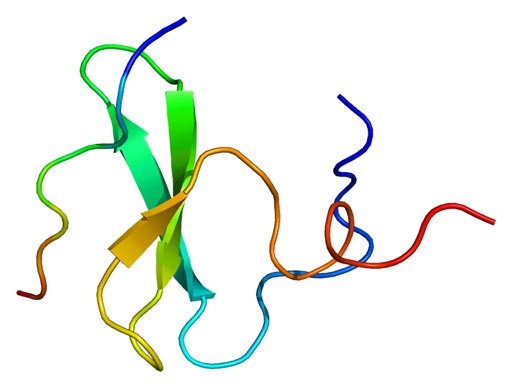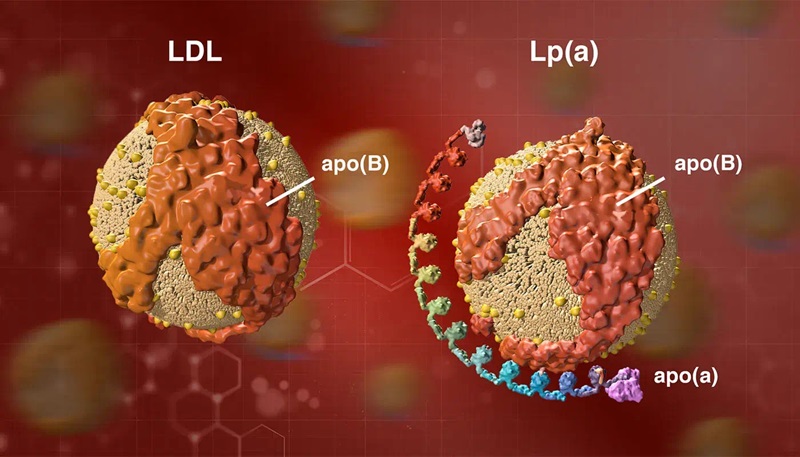Disrupted Molecular Signaling Drives Cancer Metastasis
|
By LabMedica International staff writers Posted on 24 Jan 2017 |

Image: Molecular model of YAP (Yes-associated protein) (Photo courtesy of Wikimedia Commons).
A malfunction in molecular signaling that continually activates Yes-associated protein (YAP) has been linked to the ability of metastatic cancer cells to break away from the extracellular matrix (ECM) and travel throughout the body.
In order to study the interaction between YAP and ECM, investigators at The Institute of Cancer Research had to solve the technical challenge caused by perturbations that affect cell shape and, indirectly, protein localization. To this end they developed a method using single-cell image analysis and statistical models that exploited the naturally occurring heterogeneity of cellular populations.
The investigators then systematically deleted 950 individual genes in cancer cell lines to identify any that influenced YAP signaling. They reported in the January 5, 2017, online edition of the journal Cell Systems that the proteins beta-PIX and PAK2, were the drivers behind both YAP activation and cell-ECM adhesion turnover during cell spreading.
To examine how YAP's activity was controlled in cancer cells, the investigators worked with cultures of triple-negative breast cancer cells that were derived either from a primary tumor or from a metastatic site. They found that if the beta-PIX pathway was disabled in cells from the primary tumor, YAP failed to activate. In contrast, in cells taken from the site of metastasis, YAP did activate. This finding indicated that invasive cancer cells sustained high levels of YAP even when not bound to the surrounding matrix.
Senior author Dr. Chris Bakal, leader of the dynamical cell systems team at The Institute of Cancer Research, said, "Our research shows how cancer cells that have become invasive are able overcome the normal constraints on cell movement. Cancer cells that have spread around the body have a switch which is jammed on - allowing them to produce a molecule called YAP all the time. This allows them to keep growing and spreading throughout the body, ignoring the physical controls that would normally stop this happening. Understanding more about the physical processes which constrain and control the growth and movement of cells can open up exciting new avenues for cancer treatment, which may have been missed until now."
In order to study the interaction between YAP and ECM, investigators at The Institute of Cancer Research had to solve the technical challenge caused by perturbations that affect cell shape and, indirectly, protein localization. To this end they developed a method using single-cell image analysis and statistical models that exploited the naturally occurring heterogeneity of cellular populations.
The investigators then systematically deleted 950 individual genes in cancer cell lines to identify any that influenced YAP signaling. They reported in the January 5, 2017, online edition of the journal Cell Systems that the proteins beta-PIX and PAK2, were the drivers behind both YAP activation and cell-ECM adhesion turnover during cell spreading.
To examine how YAP's activity was controlled in cancer cells, the investigators worked with cultures of triple-negative breast cancer cells that were derived either from a primary tumor or from a metastatic site. They found that if the beta-PIX pathway was disabled in cells from the primary tumor, YAP failed to activate. In contrast, in cells taken from the site of metastasis, YAP did activate. This finding indicated that invasive cancer cells sustained high levels of YAP even when not bound to the surrounding matrix.
Senior author Dr. Chris Bakal, leader of the dynamical cell systems team at The Institute of Cancer Research, said, "Our research shows how cancer cells that have become invasive are able overcome the normal constraints on cell movement. Cancer cells that have spread around the body have a switch which is jammed on - allowing them to produce a molecule called YAP all the time. This allows them to keep growing and spreading throughout the body, ignoring the physical controls that would normally stop this happening. Understanding more about the physical processes which constrain and control the growth and movement of cells can open up exciting new avenues for cancer treatment, which may have been missed until now."
Latest BioResearch News
- Genome Analysis Predicts Likelihood of Neurodisability in Oxygen-Deprived Newborns
- Gene Panel Predicts Disease Progession for Patients with B-cell Lymphoma
- New Method Simplifies Preparation of Tumor Genomic DNA Libraries
- New Tool Developed for Diagnosis of Chronic HBV Infection
- Panel of Genetic Loci Accurately Predicts Risk of Developing Gout
- Disrupted TGFB Signaling Linked to Increased Cancer-Related Bacteria
- Gene Fusion Protein Proposed as Prostate Cancer Biomarker
- NIV Test to Diagnose and Monitor Vascular Complications in Diabetes
- Semen Exosome MicroRNA Proves Biomarker for Prostate Cancer
- Genetic Loci Link Plasma Lipid Levels to CVD Risk
- Newly Identified Gene Network Aids in Early Diagnosis of Autism Spectrum Disorder
- Link Confirmed between Living in Poverty and Developing Diseases
- Genomic Study Identifies Kidney Disease Loci in Type I Diabetes Patients
- Liquid Biopsy More Effective for Analyzing Tumor Drug Resistance Mutations
- New Liquid Biopsy Assay Reveals Host-Pathogen Interactions
- Method Developed for Enriching Trophoblast Population in Samples
Channels
Clinical Chemistry
view channel
New ADLM Guidance Provides Expert Recommendations on Clinical Testing For Respiratory Viral Infections
Respiratory tract infections, predominantly caused by viral pathogens, are a common reason for healthcare visits. Accurate and swift diagnosis of these infections is essential for optimal patient management.... Read more
3D Printed Point-Of-Care Mass Spectrometer Outperforms State-Of-The-Art Models
Mass spectrometry is a precise technique for identifying the chemical components of a sample and has significant potential for monitoring chronic illness health states, such as measuring hormone levels... Read more.jpg)
POC Biomedical Test Spins Water Droplet Using Sound Waves for Cancer Detection
Exosomes, tiny cellular bioparticles carrying a specific set of proteins, lipids, and genetic materials, play a crucial role in cell communication and hold promise for non-invasive diagnostics.... Read more
Highly Reliable Cell-Based Assay Enables Accurate Diagnosis of Endocrine Diseases
The conventional methods for measuring free cortisol, the body's stress hormone, from blood or saliva are quite demanding and require sample processing. The most common method, therefore, involves collecting... Read moreMolecular Diagnostics
view channel
Novel Technique Detects Novel Biomarkers for Kidney Diseases with Nephritic Syndrome
Nephrotic syndrome is associated with several kidney diseases such as minimal change disease (MCD), primary focal segmental glomerulosclerosis (FSGS), and membranous nephropathy (MN), and is characterized... Read more
Lipoprotein Blood Test Detects Hereditary Cardiovascular Risk
Lipoprotein (a), or Lp(a), is increasingly recognized as a critical but under-acknowledged potential risk factor for cardiovascular diseases, which are a significant public health concern.... Read more
Whole Genome Sequencing Detects Infection Transmission in NICU
A new study has shown that whole genome sequencing (WGS) of bacterial pathogens acquired from surveillance in a neonatal intensive care unit (NICU) can reveal significant infection transmission that goes... Read more
Novel Inexpensive, Shelf-Stable, Easy To Use Tests Bring Lab-Level Precision at POC
One of the most critical measurements in healthcare is the blood cell count, which can provide insights into a range of conditions from infections and autoimmune diseases to cancer. Traditionally, collecting... Read moreHematology
view channel
Next Generation Instrument Screens for Hemoglobin Disorders in Newborns
Hemoglobinopathies, the most widespread inherited conditions globally, affect about 7% of the population as carriers, with 2.7% of newborns being born with these conditions. The spectrum of clinical manifestations... Read more
First 4-in-1 Nucleic Acid Test for Arbovirus Screening to Reduce Risk of Transfusion-Transmitted Infections
Arboviruses represent an emerging global health threat, exacerbated by climate change and increased international travel that is facilitating their spread across new regions. Chikungunya, dengue, West... Read more
POC Finger-Prick Blood Test Determines Risk of Neutropenic Sepsis in Patients Undergoing Chemotherapy
Neutropenia, a decrease in neutrophils (a type of white blood cell crucial for fighting infections), is a frequent side effect of certain cancer treatments. This condition elevates the risk of infections,... Read more
First Affordable and Rapid Test for Beta Thalassemia Demonstrates 99% Diagnostic Accuracy
Hemoglobin disorders rank as some of the most prevalent monogenic diseases globally. Among various hemoglobin disorders, beta thalassemia, a hereditary blood disorder, affects about 1.5% of the world's... Read moreImmunology
view channel
Blood Test Measures Immune Response to Epstein-Barr Virus in MS Patients
Multiple sclerosis (MS) is a chronic neurological condition for which there is currently no cure. It affects around three million people globally and ranks as the second most common cause of disability... Read more.jpg)
AI Predicts Tumor-Killing Cells with High Accuracy
Cellular immunotherapy involves extracting immune cells from a patient's tumor, potentially enhancing their cancer-fighting capabilities through engineering, and then expanding and reintroducing them into the body.... Read more
Diagnostic Blood Test for Cellular Rejection after Organ Transplant Could Replace Surgical Biopsies
Transplanted organs constantly face the risk of being rejected by the recipient's immune system which differentiates self from non-self using T cells and B cells. T cells are commonly associated with acute... Read more
AI Tool Precisely Matches Cancer Drugs to Patients Using Information from Each Tumor Cell
Current strategies for matching cancer patients with specific treatments often depend on bulk sequencing of tumor DNA and RNA, which provides an average profile from all cells within a tumor sample.... Read moreMicrobiology
view channel
Integrated Solution Ushers New Era of Automated Tuberculosis Testing
Tuberculosis (TB) is responsible for 1.3 million deaths every year, positioning it as one of the top killers globally due to a single infectious agent. In 2022, around 10.6 million people were diagnosed... Read more
Automated Sepsis Test System Enables Rapid Diagnosis for Patients with Severe Bloodstream Infections
Sepsis affects up to 50 million people globally each year, with bacteraemia, formerly known as blood poisoning, being a major cause. In the United States alone, approximately two million individuals are... Read moreEnhanced Rapid Syndromic Molecular Diagnostic Solution Detects Broad Range of Infectious Diseases
GenMark Diagnostics (Carlsbad, CA, USA), a member of the Roche Group (Basel, Switzerland), has rebranded its ePlex® system as the cobas eplex system. This rebranding under the globally renowned cobas name... Read more
Clinical Decision Support Software a Game-Changer in Antimicrobial Resistance Battle
Antimicrobial resistance (AMR) is a serious global public health concern that claims millions of lives every year. It primarily results from the inappropriate and excessive use of antibiotics, which reduces... Read morePathology
view channel
AI Tool Detects Tiny Protein Clumps in Microscopy Images in Real-Time
Over 55 million individuals worldwide suffer from dementia-related diseases like Alzheimer's and Parkinson's. These conditions are caused by the clumping together of the smallest building blocks in the... Read more
New Tool Enables Better Classification of Inherited Disease-Causing Variants
Whole genome and exome sequencing are increasingly available for clinical research, aiding in the detection of inherited genetic variants that may cause various diseases. The American College of Medical... Read more
Groundbreaking CRISPR Screen Technology Rapidly Determines Disease Mechanism from Tissues
Thanks to over a decade of advancements in human genetics, scientists have compiled extensive lists of genetic variations linked to a wide array of human diseases. However, understanding how a gene contributes... Read moreTechnology
view channel
New Diagnostic System Achieves PCR Testing Accuracy
While PCR tests are the gold standard of accuracy for virology testing, they come with limitations such as complexity, the need for skilled lab operators, and longer result times. They also require complex... Read more
DNA Biosensor Enables Early Diagnosis of Cervical Cancer
Molybdenum disulfide (MoS2), recognized for its potential to form two-dimensional nanosheets like graphene, is a material that's increasingly catching the eye of the scientific community.... Read more
Self-Heating Microfluidic Devices Can Detect Diseases in Tiny Blood or Fluid Samples
Microfluidics, which are miniature devices that control the flow of liquids and facilitate chemical reactions, play a key role in disease detection from small samples of blood or other fluids.... Read more
Breakthrough in Diagnostic Technology Could Make On-The-Spot Testing Widely Accessible
Home testing gained significant importance during the COVID-19 pandemic, yet the availability of rapid tests is limited, and most of them can only drive one liquid across the strip, leading to continued... Read moreIndustry
view channel
Roche and Hitachi High-Tech Extend 46-Year Partnership for Breakthroughs in Diagnostic Testing
Roche (Basel, Switzerland) and Hitachi High-Tech (Tokyo, Japan) have renewed their collaboration agreement, committing to a further 10 years of partnership. This extension brings together their long-standing... Read more
Danaher and Johns Hopkins University Collaborate to Improve Neurological Diagnosis
Unlike severe traumatic brain injury (TBI), mild TBI often does not show clear correlations with abnormalities detected through head computed tomography (CT) scans. Consequently, there is a pressing need... Read more
Beckman Coulter and MeMed Expand Host Immune Response Diagnostics Partnership
Beckman Coulter Diagnostics (Brea, CA, USA) and MeMed BV (Haifa, Israel) have expanded their host immune response diagnostics partnership. Beckman Coulter is now an authorized distributor of the MeMed... Read more_1.jpg)











